A Comparative Analysis of Financial Markets: US vs. Australia
VerifiedAdded on 2023/06/12
|7
|2187
|432
Essay
AI Summary
This essay provides a comprehensive analysis of the financial instruments and markets in the United States and Australia, highlighting the role of technology, ethical considerations, and legal perspectives. It discusses the impact of technological advancements such as cloud computing, data analytics, and the Internet of Things on banking institutions, emphasizing the importance of security and risk management. The essay also explores the ethical issues related to online banking, including privacy and ownership, and addresses the legal frameworks designed to protect these services. Furthermore, it examines the continuous changes in the Australian financial sector, driven by technological innovation and the rise of Fin-tech investments, underscoring the need for banks to adopt innovations responsibly while adhering to regulatory requirements. The conclusion emphasizes the ongoing transformation of the banking sector through digitalization, with a focus on enhancing customer loyalty, efficiency, and stability.
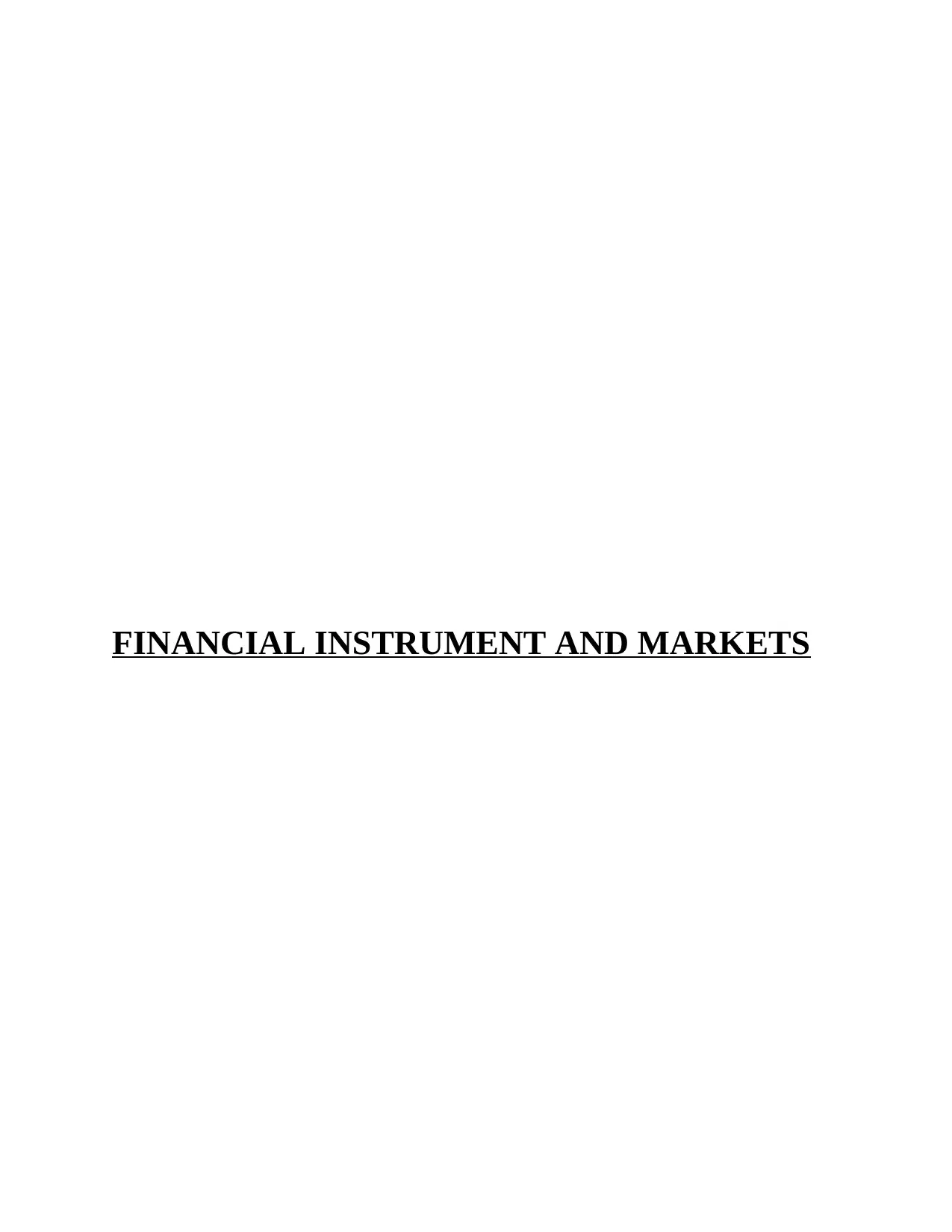
FINANCIAL INSTRUMENT AND MARKETS
Paraphrase This Document
Need a fresh take? Get an instant paraphrase of this document with our AI Paraphraser
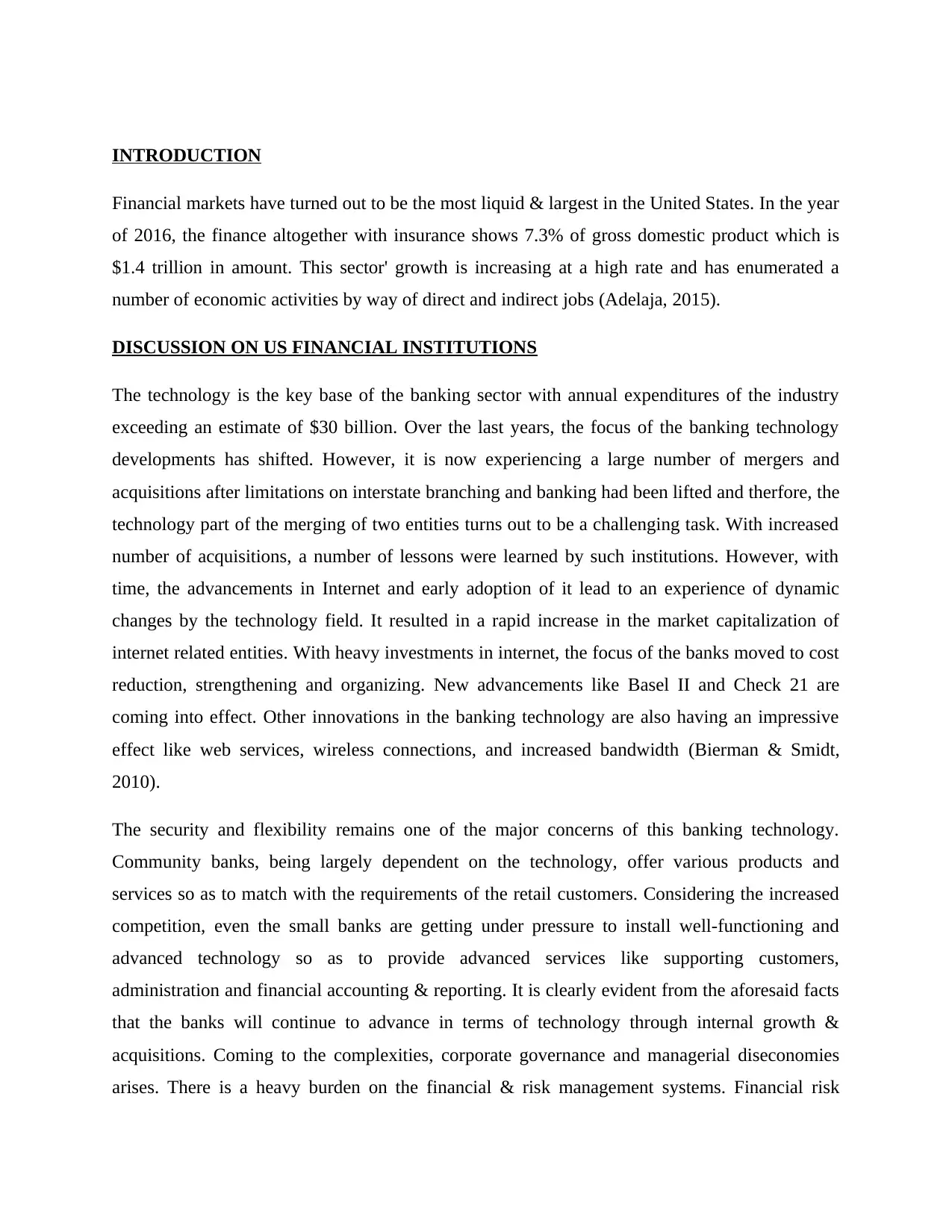
INTRODUCTION
Financial markets have turned out to be the most liquid & largest in the United States. In the year
of 2016, the finance altogether with insurance shows 7.3% of gross domestic product which is
$1.4 trillion in amount. This sector' growth is increasing at a high rate and has enumerated a
number of economic activities by way of direct and indirect jobs (Adelaja, 2015).
DISCUSSION ON US FINANCIAL INSTITUTIONS
The technology is the key base of the banking sector with annual expenditures of the industry
exceeding an estimate of $30 billion. Over the last years, the focus of the banking technology
developments has shifted. However, it is now experiencing a large number of mergers and
acquisitions after limitations on interstate branching and banking had been lifted and therfore, the
technology part of the merging of two entities turns out to be a challenging task. With increased
number of acquisitions, a number of lessons were learned by such institutions. However, with
time, the advancements in Internet and early adoption of it lead to an experience of dynamic
changes by the technology field. It resulted in a rapid increase in the market capitalization of
internet related entities. With heavy investments in internet, the focus of the banks moved to cost
reduction, strengthening and organizing. New advancements like Basel II and Check 21 are
coming into effect. Other innovations in the banking technology are also having an impressive
effect like web services, wireless connections, and increased bandwidth (Bierman & Smidt,
2010).
The security and flexibility remains one of the major concerns of this banking technology.
Community banks, being largely dependent on the technology, offer various products and
services so as to match with the requirements of the retail customers. Considering the increased
competition, even the small banks are getting under pressure to install well-functioning and
advanced technology so as to provide advanced services like supporting customers,
administration and financial accounting & reporting. It is clearly evident from the aforesaid facts
that the banks will continue to advance in terms of technology through internal growth &
acquisitions. Coming to the complexities, corporate governance and managerial diseconomies
arises. There is a heavy burden on the financial & risk management systems. Financial risk
Financial markets have turned out to be the most liquid & largest in the United States. In the year
of 2016, the finance altogether with insurance shows 7.3% of gross domestic product which is
$1.4 trillion in amount. This sector' growth is increasing at a high rate and has enumerated a
number of economic activities by way of direct and indirect jobs (Adelaja, 2015).
DISCUSSION ON US FINANCIAL INSTITUTIONS
The technology is the key base of the banking sector with annual expenditures of the industry
exceeding an estimate of $30 billion. Over the last years, the focus of the banking technology
developments has shifted. However, it is now experiencing a large number of mergers and
acquisitions after limitations on interstate branching and banking had been lifted and therfore, the
technology part of the merging of two entities turns out to be a challenging task. With increased
number of acquisitions, a number of lessons were learned by such institutions. However, with
time, the advancements in Internet and early adoption of it lead to an experience of dynamic
changes by the technology field. It resulted in a rapid increase in the market capitalization of
internet related entities. With heavy investments in internet, the focus of the banks moved to cost
reduction, strengthening and organizing. New advancements like Basel II and Check 21 are
coming into effect. Other innovations in the banking technology are also having an impressive
effect like web services, wireless connections, and increased bandwidth (Bierman & Smidt,
2010).
The security and flexibility remains one of the major concerns of this banking technology.
Community banks, being largely dependent on the technology, offer various products and
services so as to match with the requirements of the retail customers. Considering the increased
competition, even the small banks are getting under pressure to install well-functioning and
advanced technology so as to provide advanced services like supporting customers,
administration and financial accounting & reporting. It is clearly evident from the aforesaid facts
that the banks will continue to advance in terms of technology through internal growth &
acquisitions. Coming to the complexities, corporate governance and managerial diseconomies
arises. There is a heavy burden on the financial & risk management systems. Financial risk
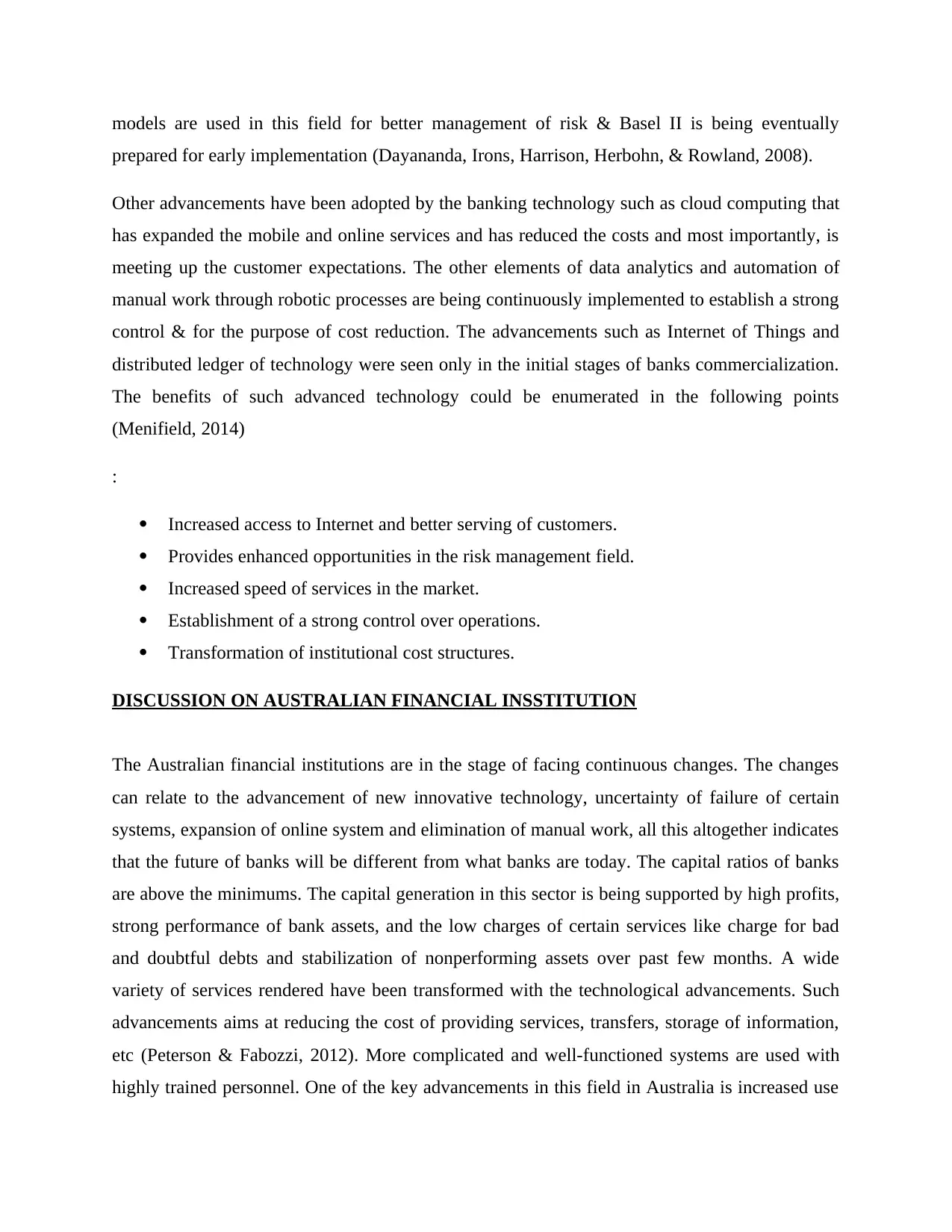
models are used in this field for better management of risk & Basel II is being eventually
prepared for early implementation (Dayananda, Irons, Harrison, Herbohn, & Rowland, 2008).
Other advancements have been adopted by the banking technology such as cloud computing that
has expanded the mobile and online services and has reduced the costs and most importantly, is
meeting up the customer expectations. The other elements of data analytics and automation of
manual work through robotic processes are being continuously implemented to establish a strong
control & for the purpose of cost reduction. The advancements such as Internet of Things and
distributed ledger of technology were seen only in the initial stages of banks commercialization.
The benefits of such advanced technology could be enumerated in the following points
(Menifield, 2014)
:
Increased access to Internet and better serving of customers.
Provides enhanced opportunities in the risk management field.
Increased speed of services in the market.
Establishment of a strong control over operations.
Transformation of institutional cost structures.
DISCUSSION ON AUSTRALIAN FINANCIAL INSSTITUTION
The Australian financial institutions are in the stage of facing continuous changes. The changes
can relate to the advancement of new innovative technology, uncertainty of failure of certain
systems, expansion of online system and elimination of manual work, all this altogether indicates
that the future of banks will be different from what banks are today. The capital ratios of banks
are above the minimums. The capital generation in this sector is being supported by high profits,
strong performance of bank assets, and the low charges of certain services like charge for bad
and doubtful debts and stabilization of nonperforming assets over past few months. A wide
variety of services rendered have been transformed with the technological advancements. Such
advancements aims at reducing the cost of providing services, transfers, storage of information,
etc (Peterson & Fabozzi, 2012). More complicated and well-functioned systems are used with
highly trained personnel. One of the key advancements in this field in Australia is increased use
prepared for early implementation (Dayananda, Irons, Harrison, Herbohn, & Rowland, 2008).
Other advancements have been adopted by the banking technology such as cloud computing that
has expanded the mobile and online services and has reduced the costs and most importantly, is
meeting up the customer expectations. The other elements of data analytics and automation of
manual work through robotic processes are being continuously implemented to establish a strong
control & for the purpose of cost reduction. The advancements such as Internet of Things and
distributed ledger of technology were seen only in the initial stages of banks commercialization.
The benefits of such advanced technology could be enumerated in the following points
(Menifield, 2014)
:
Increased access to Internet and better serving of customers.
Provides enhanced opportunities in the risk management field.
Increased speed of services in the market.
Establishment of a strong control over operations.
Transformation of institutional cost structures.
DISCUSSION ON AUSTRALIAN FINANCIAL INSSTITUTION
The Australian financial institutions are in the stage of facing continuous changes. The changes
can relate to the advancement of new innovative technology, uncertainty of failure of certain
systems, expansion of online system and elimination of manual work, all this altogether indicates
that the future of banks will be different from what banks are today. The capital ratios of banks
are above the minimums. The capital generation in this sector is being supported by high profits,
strong performance of bank assets, and the low charges of certain services like charge for bad
and doubtful debts and stabilization of nonperforming assets over past few months. A wide
variety of services rendered have been transformed with the technological advancements. Such
advancements aims at reducing the cost of providing services, transfers, storage of information,
etc (Peterson & Fabozzi, 2012). More complicated and well-functioned systems are used with
highly trained personnel. One of the key advancements in this field in Australia is increased use
⊘ This is a preview!⊘
Do you want full access?
Subscribe today to unlock all pages.

Trusted by 1+ million students worldwide
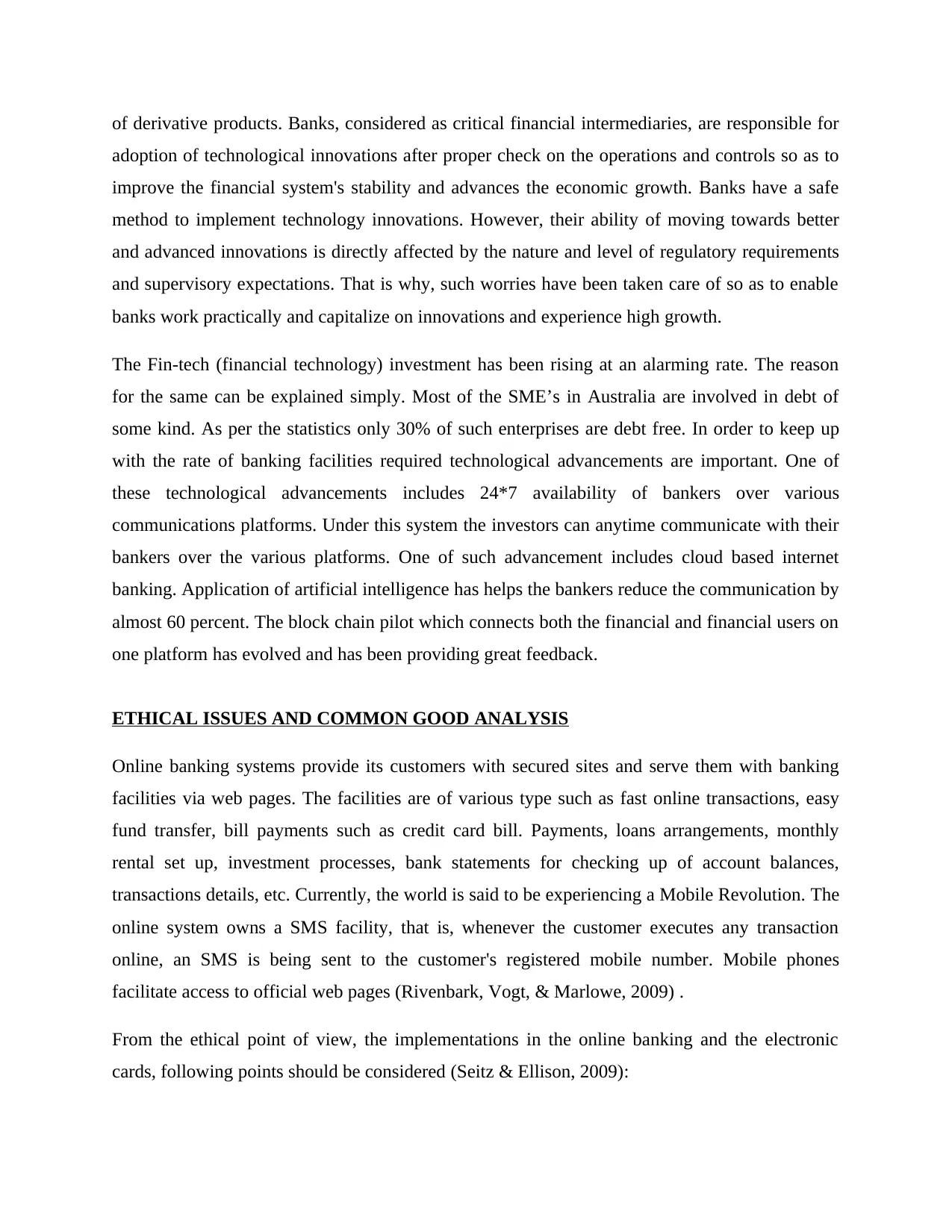
of derivative products. Banks, considered as critical financial intermediaries, are responsible for
adoption of technological innovations after proper check on the operations and controls so as to
improve the financial system's stability and advances the economic growth. Banks have a safe
method to implement technology innovations. However, their ability of moving towards better
and advanced innovations is directly affected by the nature and level of regulatory requirements
and supervisory expectations. That is why, such worries have been taken care of so as to enable
banks work practically and capitalize on innovations and experience high growth.
The Fin-tech (financial technology) investment has been rising at an alarming rate. The reason
for the same can be explained simply. Most of the SME’s in Australia are involved in debt of
some kind. As per the statistics only 30% of such enterprises are debt free. In order to keep up
with the rate of banking facilities required technological advancements are important. One of
these technological advancements includes 24*7 availability of bankers over various
communications platforms. Under this system the investors can anytime communicate with their
bankers over the various platforms. One of such advancement includes cloud based internet
banking. Application of artificial intelligence has helps the bankers reduce the communication by
almost 60 percent. The block chain pilot which connects both the financial and financial users on
one platform has evolved and has been providing great feedback.
ETHICAL ISSUES AND COMMON GOOD ANALYSIS
Online banking systems provide its customers with secured sites and serve them with banking
facilities via web pages. The facilities are of various type such as fast online transactions, easy
fund transfer, bill payments such as credit card bill. Payments, loans arrangements, monthly
rental set up, investment processes, bank statements for checking up of account balances,
transactions details, etc. Currently, the world is said to be experiencing a Mobile Revolution. The
online system owns a SMS facility, that is, whenever the customer executes any transaction
online, an SMS is being sent to the customer's registered mobile number. Mobile phones
facilitate access to official web pages (Rivenbark, Vogt, & Marlowe, 2009) .
From the ethical point of view, the implementations in the online banking and the electronic
cards, following points should be considered (Seitz & Ellison, 2009):
adoption of technological innovations after proper check on the operations and controls so as to
improve the financial system's stability and advances the economic growth. Banks have a safe
method to implement technology innovations. However, their ability of moving towards better
and advanced innovations is directly affected by the nature and level of regulatory requirements
and supervisory expectations. That is why, such worries have been taken care of so as to enable
banks work practically and capitalize on innovations and experience high growth.
The Fin-tech (financial technology) investment has been rising at an alarming rate. The reason
for the same can be explained simply. Most of the SME’s in Australia are involved in debt of
some kind. As per the statistics only 30% of such enterprises are debt free. In order to keep up
with the rate of banking facilities required technological advancements are important. One of
these technological advancements includes 24*7 availability of bankers over various
communications platforms. Under this system the investors can anytime communicate with their
bankers over the various platforms. One of such advancement includes cloud based internet
banking. Application of artificial intelligence has helps the bankers reduce the communication by
almost 60 percent. The block chain pilot which connects both the financial and financial users on
one platform has evolved and has been providing great feedback.
ETHICAL ISSUES AND COMMON GOOD ANALYSIS
Online banking systems provide its customers with secured sites and serve them with banking
facilities via web pages. The facilities are of various type such as fast online transactions, easy
fund transfer, bill payments such as credit card bill. Payments, loans arrangements, monthly
rental set up, investment processes, bank statements for checking up of account balances,
transactions details, etc. Currently, the world is said to be experiencing a Mobile Revolution. The
online system owns a SMS facility, that is, whenever the customer executes any transaction
online, an SMS is being sent to the customer's registered mobile number. Mobile phones
facilitate access to official web pages (Rivenbark, Vogt, & Marlowe, 2009) .
From the ethical point of view, the implementations in the online banking and the electronic
cards, following points should be considered (Seitz & Ellison, 2009):
Paraphrase This Document
Need a fresh take? Get an instant paraphrase of this document with our AI Paraphraser
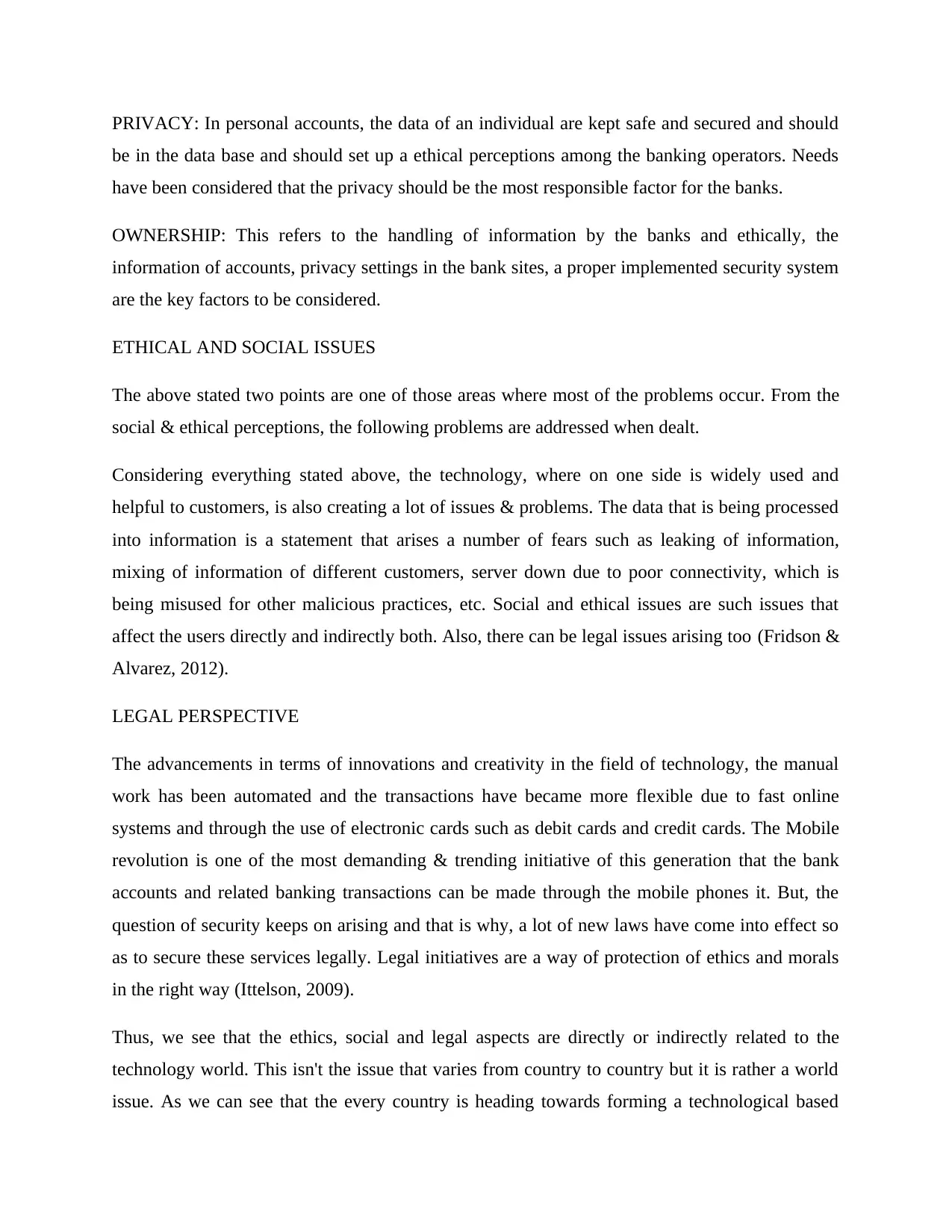
PRIVACY: In personal accounts, the data of an individual are kept safe and secured and should
be in the data base and should set up a ethical perceptions among the banking operators. Needs
have been considered that the privacy should be the most responsible factor for the banks.
OWNERSHIP: This refers to the handling of information by the banks and ethically, the
information of accounts, privacy settings in the bank sites, a proper implemented security system
are the key factors to be considered.
ETHICAL AND SOCIAL ISSUES
The above stated two points are one of those areas where most of the problems occur. From the
social & ethical perceptions, the following problems are addressed when dealt.
Considering everything stated above, the technology, where on one side is widely used and
helpful to customers, is also creating a lot of issues & problems. The data that is being processed
into information is a statement that arises a number of fears such as leaking of information,
mixing of information of different customers, server down due to poor connectivity, which is
being misused for other malicious practices, etc. Social and ethical issues are such issues that
affect the users directly and indirectly both. Also, there can be legal issues arising too (Fridson &
Alvarez, 2012).
LEGAL PERSPECTIVE
The advancements in terms of innovations and creativity in the field of technology, the manual
work has been automated and the transactions have became more flexible due to fast online
systems and through the use of electronic cards such as debit cards and credit cards. The Mobile
revolution is one of the most demanding & trending initiative of this generation that the bank
accounts and related banking transactions can be made through the mobile phones it. But, the
question of security keeps on arising and that is why, a lot of new laws have come into effect so
as to secure these services legally. Legal initiatives are a way of protection of ethics and morals
in the right way (Ittelson, 2009).
Thus, we see that the ethics, social and legal aspects are directly or indirectly related to the
technology world. This isn't the issue that varies from country to country but it is rather a world
issue. As we can see that the every country is heading towards forming a technological based
be in the data base and should set up a ethical perceptions among the banking operators. Needs
have been considered that the privacy should be the most responsible factor for the banks.
OWNERSHIP: This refers to the handling of information by the banks and ethically, the
information of accounts, privacy settings in the bank sites, a proper implemented security system
are the key factors to be considered.
ETHICAL AND SOCIAL ISSUES
The above stated two points are one of those areas where most of the problems occur. From the
social & ethical perceptions, the following problems are addressed when dealt.
Considering everything stated above, the technology, where on one side is widely used and
helpful to customers, is also creating a lot of issues & problems. The data that is being processed
into information is a statement that arises a number of fears such as leaking of information,
mixing of information of different customers, server down due to poor connectivity, which is
being misused for other malicious practices, etc. Social and ethical issues are such issues that
affect the users directly and indirectly both. Also, there can be legal issues arising too (Fridson &
Alvarez, 2012).
LEGAL PERSPECTIVE
The advancements in terms of innovations and creativity in the field of technology, the manual
work has been automated and the transactions have became more flexible due to fast online
systems and through the use of electronic cards such as debit cards and credit cards. The Mobile
revolution is one of the most demanding & trending initiative of this generation that the bank
accounts and related banking transactions can be made through the mobile phones it. But, the
question of security keeps on arising and that is why, a lot of new laws have come into effect so
as to secure these services legally. Legal initiatives are a way of protection of ethics and morals
in the right way (Ittelson, 2009).
Thus, we see that the ethics, social and legal aspects are directly or indirectly related to the
technology world. This isn't the issue that varies from country to country but it is rather a world
issue. As we can see that the every country is heading towards forming a technological based
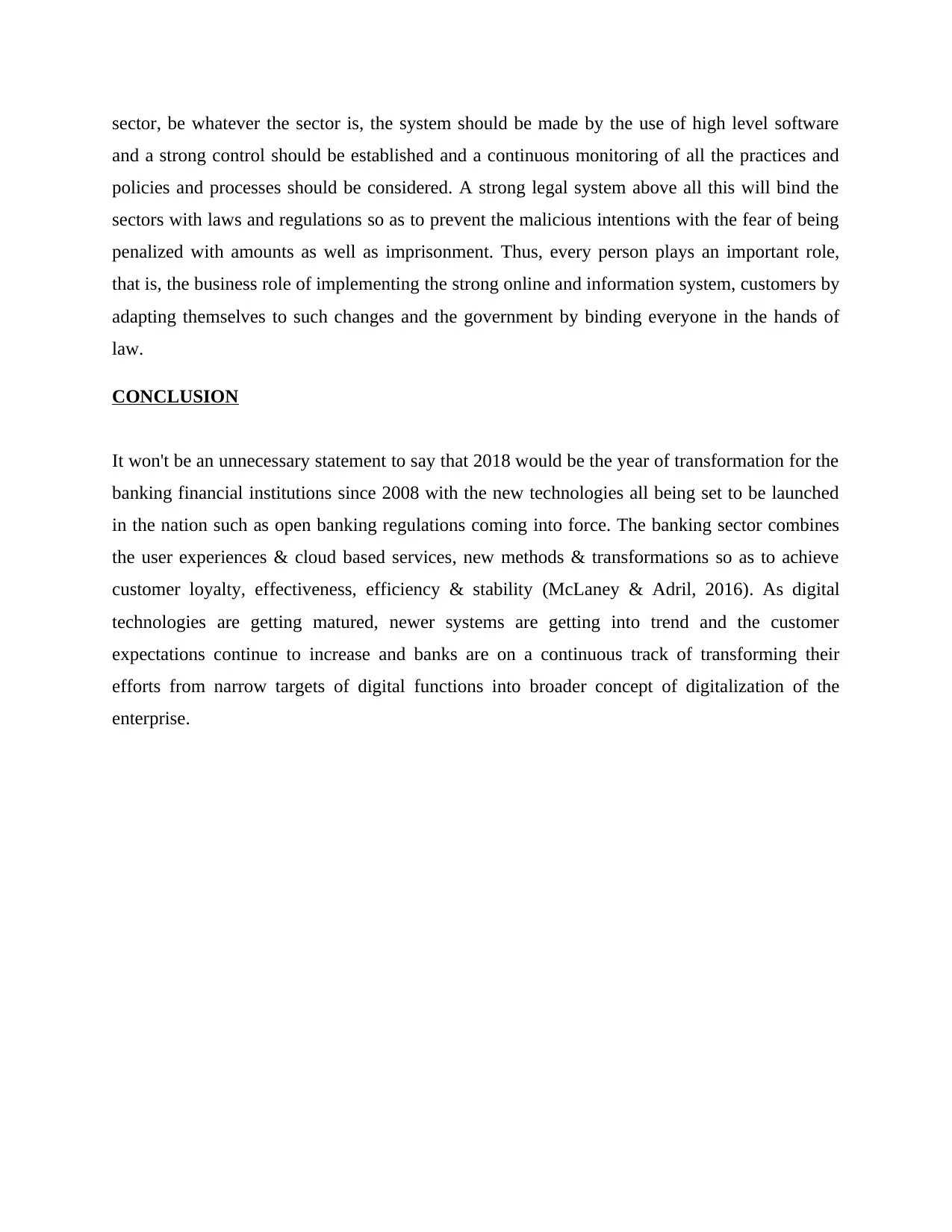
sector, be whatever the sector is, the system should be made by the use of high level software
and a strong control should be established and a continuous monitoring of all the practices and
policies and processes should be considered. A strong legal system above all this will bind the
sectors with laws and regulations so as to prevent the malicious intentions with the fear of being
penalized with amounts as well as imprisonment. Thus, every person plays an important role,
that is, the business role of implementing the strong online and information system, customers by
adapting themselves to such changes and the government by binding everyone in the hands of
law.
CONCLUSION
It won't be an unnecessary statement to say that 2018 would be the year of transformation for the
banking financial institutions since 2008 with the new technologies all being set to be launched
in the nation such as open banking regulations coming into force. The banking sector combines
the user experiences & cloud based services, new methods & transformations so as to achieve
customer loyalty, effectiveness, efficiency & stability (McLaney & Adril, 2016). As digital
technologies are getting matured, newer systems are getting into trend and the customer
expectations continue to increase and banks are on a continuous track of transforming their
efforts from narrow targets of digital functions into broader concept of digitalization of the
enterprise.
and a strong control should be established and a continuous monitoring of all the practices and
policies and processes should be considered. A strong legal system above all this will bind the
sectors with laws and regulations so as to prevent the malicious intentions with the fear of being
penalized with amounts as well as imprisonment. Thus, every person plays an important role,
that is, the business role of implementing the strong online and information system, customers by
adapting themselves to such changes and the government by binding everyone in the hands of
law.
CONCLUSION
It won't be an unnecessary statement to say that 2018 would be the year of transformation for the
banking financial institutions since 2008 with the new technologies all being set to be launched
in the nation such as open banking regulations coming into force. The banking sector combines
the user experiences & cloud based services, new methods & transformations so as to achieve
customer loyalty, effectiveness, efficiency & stability (McLaney & Adril, 2016). As digital
technologies are getting matured, newer systems are getting into trend and the customer
expectations continue to increase and banks are on a continuous track of transforming their
efforts from narrow targets of digital functions into broader concept of digitalization of the
enterprise.
⊘ This is a preview!⊘
Do you want full access?
Subscribe today to unlock all pages.

Trusted by 1+ million students worldwide
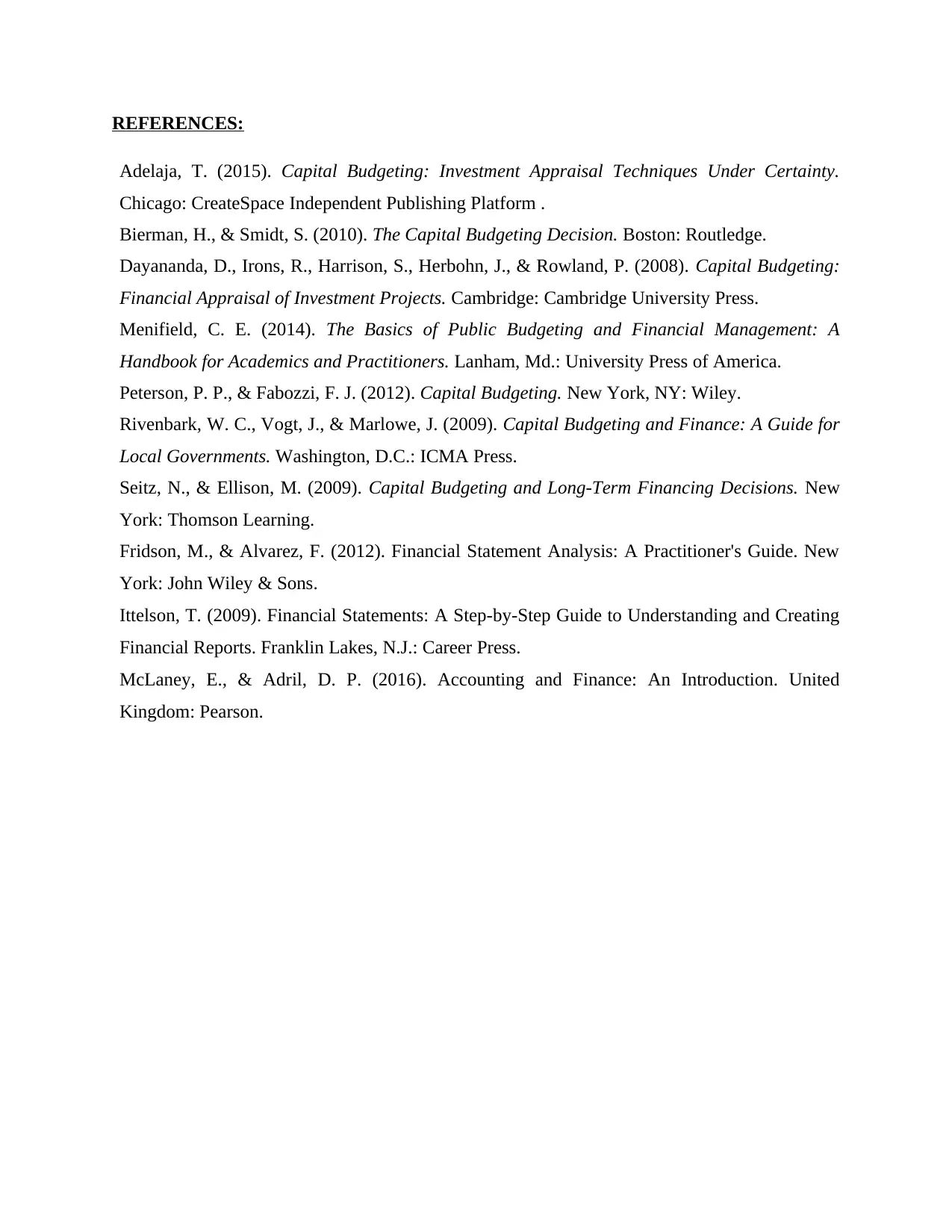
REFERENCES:
Adelaja, T. (2015). Capital Budgeting: Investment Appraisal Techniques Under Certainty.
Chicago: CreateSpace Independent Publishing Platform .
Bierman, H., & Smidt, S. (2010). The Capital Budgeting Decision. Boston: Routledge.
Dayananda, D., Irons, R., Harrison, S., Herbohn, J., & Rowland, P. (2008). Capital Budgeting:
Financial Appraisal of Investment Projects. Cambridge: Cambridge University Press.
Menifield, C. E. (2014). The Basics of Public Budgeting and Financial Management: A
Handbook for Academics and Practitioners. Lanham, Md.: University Press of America.
Peterson, P. P., & Fabozzi, F. J. (2012). Capital Budgeting. New York, NY: Wiley.
Rivenbark, W. C., Vogt, J., & Marlowe, J. (2009). Capital Budgeting and Finance: A Guide for
Local Governments. Washington, D.C.: ICMA Press.
Seitz, N., & Ellison, M. (2009). Capital Budgeting and Long-Term Financing Decisions. New
York: Thomson Learning.
Fridson, M., & Alvarez, F. (2012). Financial Statement Analysis: A Practitioner's Guide. New
York: John Wiley & Sons.
Ittelson, T. (2009). Financial Statements: A Step-by-Step Guide to Understanding and Creating
Financial Reports. Franklin Lakes, N.J.: Career Press.
McLaney, E., & Adril, D. P. (2016). Accounting and Finance: An Introduction. United
Kingdom: Pearson.
Adelaja, T. (2015). Capital Budgeting: Investment Appraisal Techniques Under Certainty.
Chicago: CreateSpace Independent Publishing Platform .
Bierman, H., & Smidt, S. (2010). The Capital Budgeting Decision. Boston: Routledge.
Dayananda, D., Irons, R., Harrison, S., Herbohn, J., & Rowland, P. (2008). Capital Budgeting:
Financial Appraisal of Investment Projects. Cambridge: Cambridge University Press.
Menifield, C. E. (2014). The Basics of Public Budgeting and Financial Management: A
Handbook for Academics and Practitioners. Lanham, Md.: University Press of America.
Peterson, P. P., & Fabozzi, F. J. (2012). Capital Budgeting. New York, NY: Wiley.
Rivenbark, W. C., Vogt, J., & Marlowe, J. (2009). Capital Budgeting and Finance: A Guide for
Local Governments. Washington, D.C.: ICMA Press.
Seitz, N., & Ellison, M. (2009). Capital Budgeting and Long-Term Financing Decisions. New
York: Thomson Learning.
Fridson, M., & Alvarez, F. (2012). Financial Statement Analysis: A Practitioner's Guide. New
York: John Wiley & Sons.
Ittelson, T. (2009). Financial Statements: A Step-by-Step Guide to Understanding and Creating
Financial Reports. Franklin Lakes, N.J.: Career Press.
McLaney, E., & Adril, D. P. (2016). Accounting and Finance: An Introduction. United
Kingdom: Pearson.
1 out of 7
Related Documents
Your All-in-One AI-Powered Toolkit for Academic Success.
+13062052269
info@desklib.com
Available 24*7 on WhatsApp / Email
![[object Object]](/_next/static/media/star-bottom.7253800d.svg)
Unlock your academic potential
Copyright © 2020–2025 A2Z Services. All Rights Reserved. Developed and managed by ZUCOL.




